_770.jpg)
Everyone knows that none of the mathematical betting systems for roulette is advantageous. None of them ensures long-term profit. Sooner or later, you will fail, and massive losses and disappointment often accompany this.
- But what about visual ballistics, which belongs to the physical systems?
- Is there any evidence that it can help you earn money playing roulette?
- Do you know how to do this?
Our article covers the issues mentioned above.
What Is Roulette Visual Ballistics?
Casino owners are so sure that the outcomes of roulette spins are random that they even allow customers to place bets while the ball is running along the track. Researchers know all physical quantities that determine outcomes:
- ball speed,
- wheel speed,
- and friction force.
When a croupier spins a ball, the gameplay becomes strictly deterministic and cannot be changed. If you know all the factors, you should be able to calculate the outcome. This is precisely the task of visual ballistics.
However, it is not that simple. Any spin consists of two different phases.
- During the first phase, the ball rolls smoothly and evenly on the ball track, and its motion is easily predictable at this stage.
- Yet, it is followed by the chaotic phase: the ball moves down to the bottom of the bowl and bounces off one of the deflectors in random directions.
Then, it falls into one of 37 pockets. How is it possible to predict an outcome in such cases? It turns out that this is possible.
Is It Possible to Master Visual Ballistics for Roulette?
On the Internet, many sites create the impression that it is quite possible to master visual ballistics. Some tutorials for this system are even available. This can be true, but even if so, you must go a long way in losses and disappointments.
Nevertheless, common sense dictates that years of mastering visual ballistics are unnecessary for a straightforward reason: the roulette wheel speed at casinos constantly grows.
Is it challenging to learn how to use this system? Let's look at the example of one of the most famous experts on visual ballistics, Christian Kaisan.
Who Is Christian Kaisan?
Christian Kaisan spent three years implementing this idea. In the early eighties, this thought came to his mind, and he spent three years (from 1981 to 1984) collecting information, analyzing it, and getting prepared to gamble. During that time, he did not gamble. He attended casinos about three hundred times for three years. He studied different bowls and balls, the influence of deflectors on bouncing, and calculated a lot.
He placed his first bet as soon as he could evaluate the impact of all these factors. Christian Kaisan won millions of dollars in the next 20 years using his technique of visual ballistics.

Christian Kaisan was well prepared. He could evaluate the dealer's rhythm, predict a pocket into which a ball will fall, and calculate the ball's and wheel's speeds. But when he started gambling, he realized that his training had not been in vain. During the first six weeks, he won 70,000 German marks. And it was only the beginning.
He started traveling around the world and visited all the major casinos. And he succeeded in winning! In Australia, Christian Kaisan won 500 thousand dollars for three days. He could hit his highest jackpot in Copenhagen, which reached 126 thousand dollars. Christian Kaisan attended many casinos in the United States, especially in Las Vegas, and won almost everywhere.
Christian Kaisan said his success was based on two-thirds of his abilities and skills and one-third of his perception. He could sense how the dealer threw the ball, its force, and his sense of time. This feeling appeared only after many years of observations at the roulette table.
Principles That Make Roulette Predictable
Most people believe that the outcome of each spin is random. However, this is not true since it is almost impossible to construct a roulette wheel that generates indeed unpredictable outcomes. Many professional players find, understand, and use the defects to make a profit. Casinos are trying to react to such activities of players using modern technologies, but physical laws still govern outcomes on the roulette wheel. So, it will always be possible to beat the house.
Roulette manufacturers report on their websites that their wheels generate spins randomly. Yet behind closed doors, they admit that even completely new wheels demonstrate predictable patterns that gamblers can use in the long run. And they are not talking about defective wheels. They acknowledge that predictable outcomes are common both for new and old wheels.
Below, we will discuss some basic principles that make spin outcomes predictable. This list does not seem to be complete. Remember that professional gamblers' revenues depend on keeping specific mechanisms secret. Therefore, you will not find any complete information.
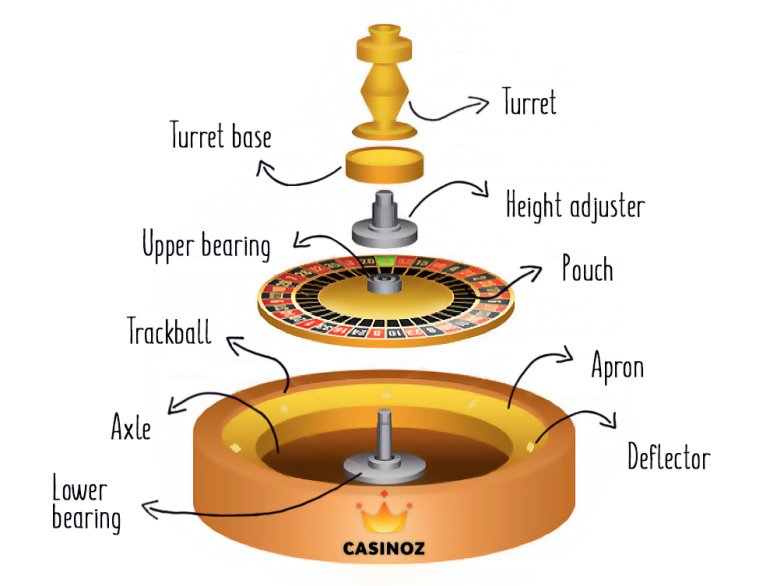
First, we should discuss all the necessary terms and the names of all structural components. The article Everything about the Roulette Wheel Construction provides a more detailed description of the roulette wheel.
- The ball track is located at the top of the roulette wheel on which a ball is moving.
- The wheelhead is a rotating numbered fragment of the wheel.
- Pockets are numbered. A ball falls into one of them, which determines the outcome.
- Timing is a period necessary for a ball to move along the ball track.
What Happens During a Spin?
When a dealer spins a ball, it moves along the ball track, gradually slowing down, losing momentum, and falling into the wheel head. Usually, the ball bounces off metal deflectors, but sometimes, it lands in a pocket without bouncing. Often, it bounces across the whole roulette wheel.
You can never predict where the ball will land, but it is unnecessary. You just need to roughly predict where the ball will fall with sufficient accuracy to reduce the house edge. It is easy to do this for some wheels, but it may seem more difficult for others.
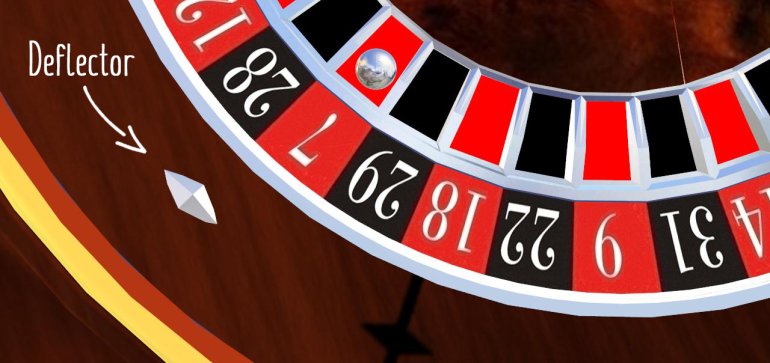
Dominant Diamonds
Worn metal deflectors arranged around the roulette wheel are the most visible signs. Virtually on each wheel, the ball bounces off some diamonds more likely than others. Therefore, they are more worn than the others. You can notice this by taking a closer look at deflectors. They are called dominant diamonds, and their dominance can be caused by a combination of different factors, including:
- Worn ball tracks. Even newly manufactured wheels have imperfect ball tracks.
- Wheel roughness. Even the slightest axial inclination may cause dominant diamonds. According to the official research of International governmental laboratories, an imbalance of 1-2 millimeters leads to the appearance of dominant diamonds.
You can hardly find a roulette wheel without significant dominant diamonds. Dominant diamonds don't appear randomly. They indicate patterns that can be used to predict the outcomes of spins.
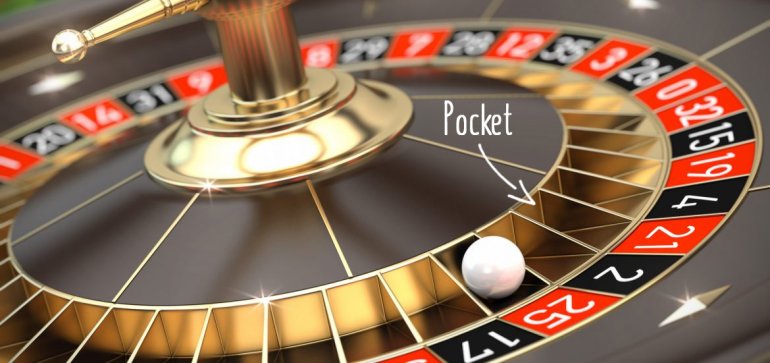
Timing
According to the logic, the timings of various spins will differ. Yet, the timings are much more similar than we can predict, especially during the last spins. The most significant deviation of timings for the minimum and maximum ball speed does not exceed 0.3 seconds.
This means that if we knew, for example, that the ball's speed was about 1.3 seconds per spin and the ball made 14 spins on the ball track, we could easily calculate that the ball would require 18.2 seconds to fall from the track into the dominant diamond. This does not occur constantly, but we need it to happen quite frequently.
Do you need to know the precise ball speed to calculate the timing for the last seven spins? It is unnecessary if you have data on the first seven spins and timings for the first and the previous spins are almost equal. Considering this information, you can conclude that a number, which will be located under the deflector when the ball bounces off it, can be easily determined. It is essential to understand this fact.
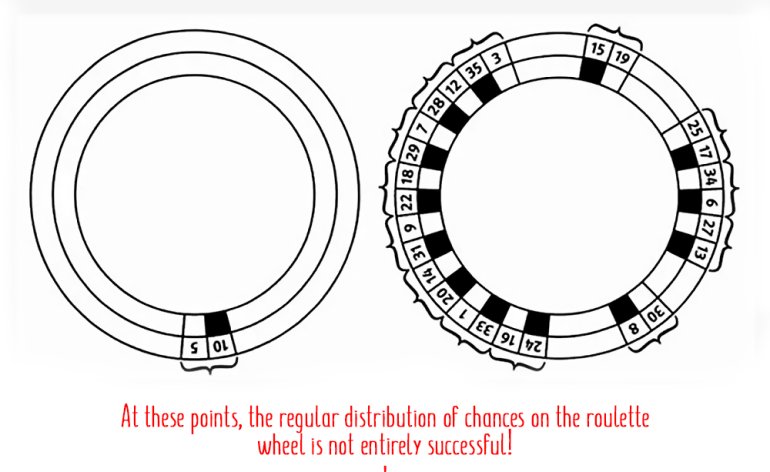
Chaotic Phase
The most unpredictable part of the spin occurs when the ball falls into the bowl and bounces off. What can be done at this stage? You can do the same thing that Christian Kaisan used to do: he observed the numerous spins and viewed how the ball bounced after falling from the ball track. Let's imagine that you have made 100 spins and noticed various options for its fall, for example:
- In 30 spins, the ball bounced off the dominant diamond, falling into one of the 5-6 pockets under the deflector, and stopped bouncing at once.
- In 15 spins, the ball bounced off the dominant diamond and reached the next deflector, bouncing off it and jumping several times from one pocket to another.
- In 25 spins, the ball bounced off any defector except for the dominant diamond.
- In 20 spins, the ball skipped all diamonds, fell into pockets, and bounced off chaotically. In 10 spins, the ball fell from the ball track, rotating on the wheel head before it landed on any pocket.
Thus, we can notice that a ball's behavior is entirely unpredictable in 2-5 cases. However, this is unimportant because we still have 30 cases mentioned in the first case. It is possible to predict their outcome. It is just necessary to find a way to predict a number that will be located under the dominant diamond where the ball falls into this pocket. Such behavior of the ball gives us a slight advantage over the house.
Thus, we cannot accurately predict winning numbers in 100 spins, even if we know where the ball will fall from the ball track. Nonetheless, 30 spins allow us to do this with relatively high accuracy. We do not consider the remaining 70 spins because 30 will provide enough accuracy to overcome the house edge equal to 2.7% in European roulette and 5.26% in the American version.
Neighbor Bets
Gamblers who play roulette using visual ballistics can determine the probability of coming up with a certain number or at least a particular sector. This can be done in a few seconds between spinning a ball and pronouncing a dealer's famous phrase, "No more bets!". This lasts for approximately 10 seconds. Therefore, professional gamblers tend to place neighbor bets.
Neighbor bets are used to stake on specific physical sectors of the roulette wheel. For example, you are playing European roulette and have concluded that the ball should fall into a pocket numbered 11. So, you want to increase your chances of winning. You should pronounce "Neighbors of 11". This means you want to stake on 11 and two adjacent numbers from both sides, i.e., 13-36-11-30-8.
Is It Possible to Use Visual Ballistics while Playing Online Roulette?
Since visual ballistics is a physical but not mathematical system, we can assume that this system is not active on the Internet. After all, at online casinos, the outcomes of spins are determined by the random number generator, which has nothing to do with the physical characteristics of the roulette wheel.
Unfortunately, you cannot use visual ballistics at live casinos. After all, it is based on the fact that you can place bets after spinning a ball. Thus, you have time to measure the wheel and ball speed. However, before a dealer spins a ball, you place your bet at all reputable live casinos, including Betfair, Paddy Power, William Hill, Ladbrokes, and Bet365. Owners of all these major brands know that visual ballistics, especially roulette computers, are dangerous to them. Therefore, they do not take a risk. Perhaps some live casinos allow betting after spinning a ball, but we do not know about them.
Why Is It Getting More Difficult to Use Visual Ballistics?
There are several reasons why it has recently become more difficult to use visual ballistics:
- The wheel speed is becoming faster.
- There are very low table limits.
- Dealers stop accepting bets too early, i.e., almost immediately after spinning a ball. This does not allow for predicting the outcomes of spins.
- Lighter and more rapid balls replace traditional balls.
- Modern roulette wheels are adjusted using computers. So, it is possible to remove even the smallest defects in bowls.
- There are wheels with shallow pockets. This means that a ball keeps jumping after bouncing off a deflector.
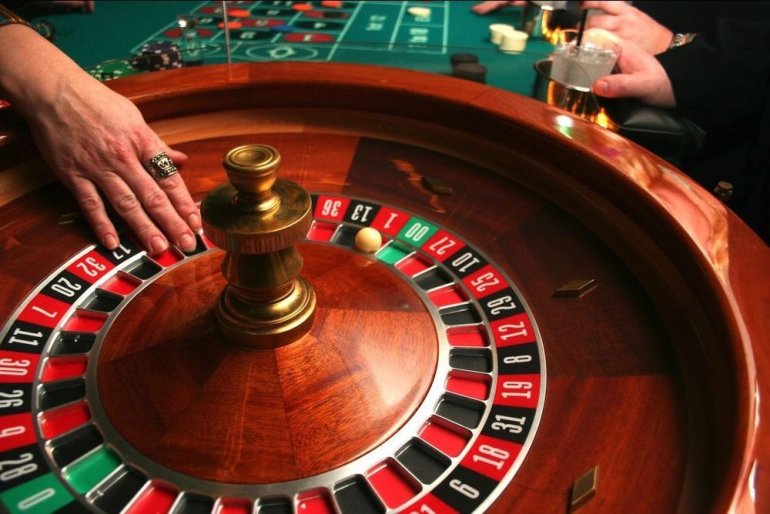
Five Important Tips
We want to try to provide some rules for the use of visual ballistics:
1. Practice.
Practice makes perfect. Practice as much as possible to play roulette using visual ballistics. Consider Christian Kaisan as an example. He had observed and analyzed data for three years before starting gambling.
2. Get as much information as possible.
To use visual ballistics efficiently, you should carefully study the construction of roulette wheels and their differences. You should know what the weight of the wheel is, which material is used to manufacture balls, how a dealer spins a ball, and so on... Knowing EVERY TINIEST DETAIL of the particular roulette wheel is necessary to start gambling and using visual ballistics!
3. Buy a roulette wheel.
When you start mastering this technique, you will need to work with some tools, for example, wristwatches, since it will be necessary to record the time of rotating wheel heads. To be sure, this is strictly prohibited in land-based casinos. For example, when Christian Kaisan tried to use his stopwatch, the administration attempted to expel him. He was blacklisted at many casinos, although the technological tools were not officially banned then. Therefore, he had to buy a few roulette wheels and practice at home.
4. Be careful.
Considering those visual ballistics should bring a profit, you should be cautious and avoid gambling too much at the same casino. Even though you don't break any law, the legislation allows casinos to expel undesirable gamblers, i.e., any player who seems to be suspicious. The same fate awaits blackjack counters: the managers notice and expel them. There is only one explanation for this fact: casinos are not happy to have customers who always win.
5. Look for suitable roulette wheels.
As soon as a specific training period has passed, you may feel that you can never achieve perfection in visual ballistics. Remember a quote from Christian Kaisan, who has described a recipe for his success in the following way: "Two-thirds of skills and one-third of the perception." You should not underestimate the sense of time.
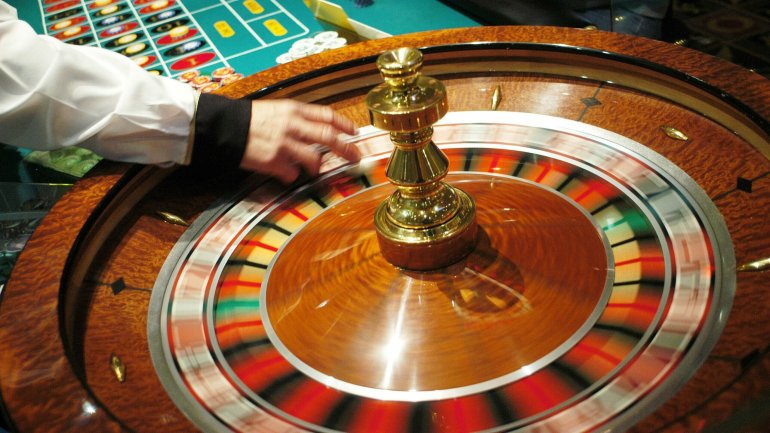
Should You Try Mastering Visual Ballistics?
Physical roulette strategies seem to be the only method that allows users to beat the house at roulette legally over the long run. From this point of view, they are considered to be the safest roulette strategies.
It is necessary to use flat bets, i.e., the bets whose sizes are equal in all spins. To be sure, you can use progressive bets, but it will be useless. And you can count on the long-term profit instead of just good luck.
Only 40-50 advantage gamblers worldwide have mastered visual ballistics.
They worked hard to master it. Anyone can learn how to use it. However, overcoming security barriers has become more difficult due to the active emergence of modern technologies. If you want to try your luck using visual ballistics, you should be clear-headed and persistent.
This method seems somewhat outdated in the current era of high-tech technologies. Now, players are trying to cheat with the help of computers with a high-level computational capacity, lasers, or radio equipment. In the future, we will publish an article dealing with so-called roulette computers that can significantly simplify visual ballisticians' problems.
If you like online roulette, here are several great games.




































